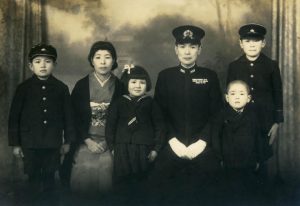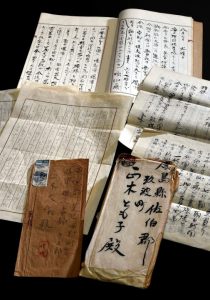Documenting Hiroshima of 1945: August 29, unable to donate own blood to son
Aug. 29, 2024
by Kyosuke Mizukawa, Senior Staff Writer
On August 29, 1945, Ikutora Masaki, a captain at the Imperial Japanese Navy Technical Department in Tokyo, wrote a letter to his wife, Tomoko, who was in Hiroshima. “I would donate half of my blood and, if that weren’t enough, all of it just to see the color return to Yoshitora’s cheeks,” wrote Mr. Masaki in the earnest hope that his oldest son, Yoshitora, 13 at the time, would recover.
Yoshitora was a first-year student at Hiroshima First Junior High School (present-day Kokutaiji High School, in Hiroshima’s Naka Ward). He had been evacuated from Tokyo and was staying at a relative’s house in Hiroshima City and commuting to school. After experiencing the atomic bombing in the school building around 850 meters from the hypocenter, he managed to make his way to the town of Kuba-cho (in present-day Otake City) in Hiroshima Prefecture, where his mother and siblings had been evacuated, on the night of August 7.
However, on August 20, he developed a fever and became bedridden. On August 21, the hair on his head began to fall out, and on August 22, his gums began to bleed. Mr. Masaki had read information from a survey conducted by the military on the atomic bombing. When he learned of his son’s symptoms through Tomoko’s letter, he wrote in his August 29 reply that, “An effect of the recent radiation is drastically reduced red and white blood cells, which can endanger human lives” and recommended a blood transfusion as “the best” option.
That day, however, Yoshitora took his last breath. He had been looking forward to reuniting with his father, saying “When will he return? It would be nice if he could return today,” wrote Tomoko in her personal account. His father was never able to leave Tokyo because of his work involving the conclusion of the war.
After the couple’s had died, their letters and journals came into the possession of Yoshitora’s younger brother, Takatora, 89, who now lives in Tokyo. “He was kind and considerate,” said Takatora of his older brother. The bedridden Yoshitaka had fashioned a badge of his junior high school out of cardboard and silver paper and was looking forward to wearing it to school after his recovery.
On August 29, specialists on radiation medicine from Tokyo headed to Hiroshima, where “A-bomb disease” was rampant.
(Originally published on August 29, 2024)
On August 29, 1945, Ikutora Masaki, a captain at the Imperial Japanese Navy Technical Department in Tokyo, wrote a letter to his wife, Tomoko, who was in Hiroshima. “I would donate half of my blood and, if that weren’t enough, all of it just to see the color return to Yoshitora’s cheeks,” wrote Mr. Masaki in the earnest hope that his oldest son, Yoshitora, 13 at the time, would recover.
Yoshitora was a first-year student at Hiroshima First Junior High School (present-day Kokutaiji High School, in Hiroshima’s Naka Ward). He had been evacuated from Tokyo and was staying at a relative’s house in Hiroshima City and commuting to school. After experiencing the atomic bombing in the school building around 850 meters from the hypocenter, he managed to make his way to the town of Kuba-cho (in present-day Otake City) in Hiroshima Prefecture, where his mother and siblings had been evacuated, on the night of August 7.
However, on August 20, he developed a fever and became bedridden. On August 21, the hair on his head began to fall out, and on August 22, his gums began to bleed. Mr. Masaki had read information from a survey conducted by the military on the atomic bombing. When he learned of his son’s symptoms through Tomoko’s letter, he wrote in his August 29 reply that, “An effect of the recent radiation is drastically reduced red and white blood cells, which can endanger human lives” and recommended a blood transfusion as “the best” option.
That day, however, Yoshitora took his last breath. He had been looking forward to reuniting with his father, saying “When will he return? It would be nice if he could return today,” wrote Tomoko in her personal account. His father was never able to leave Tokyo because of his work involving the conclusion of the war.
After the couple’s had died, their letters and journals came into the possession of Yoshitora’s younger brother, Takatora, 89, who now lives in Tokyo. “He was kind and considerate,” said Takatora of his older brother. The bedridden Yoshitaka had fashioned a badge of his junior high school out of cardboard and silver paper and was looking forward to wearing it to school after his recovery.
On August 29, specialists on radiation medicine from Tokyo headed to Hiroshima, where “A-bomb disease” was rampant.
(Originally published on August 29, 2024)









